The Yellow-billed Loon (Gavia adamsii) is a captivating bird species inhabiting the pristine Arctic regions of North America and Eurasia.
Renowned for its striking appearance and unique adaptations to extreme cold environments, this iconic loon species captivates bird enthusiasts and researchers alike.
With its large size, distinctive yellow bill, and haunting vocalizations, the Yellow-billed Loon stands out among its avian counterparts.
Its life history, including nesting habits, feeding behavior, and migration patterns, reflects a delicate balance between adaptation and survival in some of the planet’s harshest ecosystems.
As a sentinel species for environmental health, understanding and conserving the Yellow-billed Loon and its habitat are paramount for safeguarding biodiversity and ecosystem integrity in the Arctic. Stay focused.
Pick Out Characteristics of Yellow-billed Loon
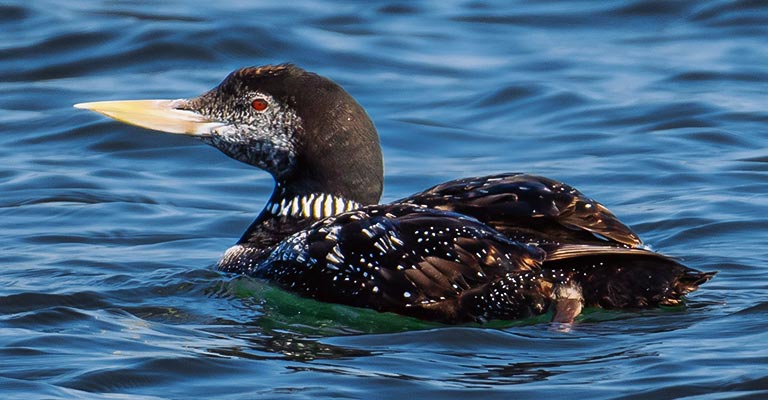
The Yellow-billed Loon (Gavia adamsii), also known as the White-billed Diver, is a striking bird primarily found in the high Arctic regions of North America and Eurasia.
With its distinct appearance and behavior, identifying this species can be exciting for bird enthusiasts. Here are some of the key characteristics to help in identifying the Yellow-billed Loon:
Distinctive Bill Color
As the name suggests, the Yellow-billed Loon’s most prominent feature is its large, bright yellow bill. This distinctive characteristic sets it apart from other loon species, making it relatively easy to identify even from a distance.
Large Size
Yellow-billed Loons are notably more significant than other loon species, measuring around 70-90 centimeters (28-35 inches) in length.
Their impressive size, combined with their striking bill coloration, makes them stand out among their counterparts.
Black and White Plumage
Like other loon species, the Yellow-billed Loon exhibits a striking contrast of black and white plumage.
Its head, neck, and upperparts are primarily black, while the underparts are white. This color pattern contributes to its elegant appearance.
Red Eyes
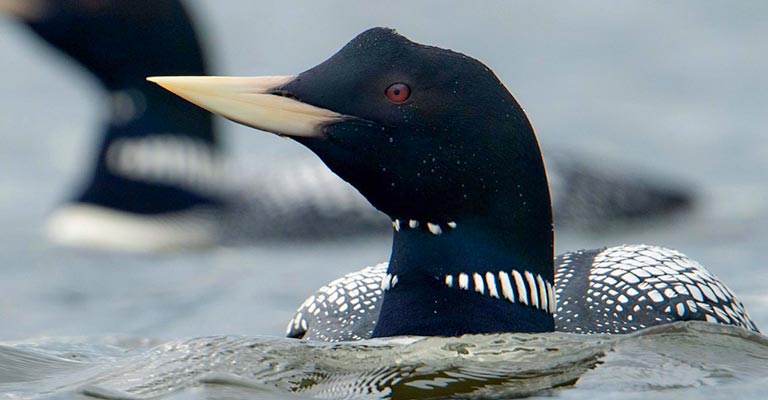
Another distinctive feature of the Yellow-billed Loon is its bright red eyes. These vividly colored eyes provide a captivating contrast against the bird’s black and white plumage, adding to its overall allure.
Long Neck and Slender Body
Yellow-billed Loons possess a long, graceful neck and a slender, streamlined body, which are adaptations for their aquatic lifestyle. These physical traits contribute to their agility and efficiency in the water.
Distinctive Vocalizations
Like other loon species, the Yellow-billed Loon is known for its haunting, mournful calls. These vocalizations are often heard during the breeding season and serve various purposes, including territory defense and mate attraction.
Preferred Habitat
Yellow-billed Loons inhabit remote, pristine Arctic lakes and coastal waters during the breeding season.
They tend to favor large, deep bodies of water with ample fish resources for feeding and nesting sites with nearby vegetation for concealment.
Seasonal Migration
During the non-breeding season, Yellow-billed Loons migrate southward to wintering grounds in more temperate coastal waters.
Their migration routes may vary, but they typically travel considerable distances to reach their wintering destinations.
Identifying the Yellow-billed Loon requires observing its distinctive physical features, listening for its vocalizations, and understanding its habitat preferences and migration patterns.
By paying attention to these critical characteristics, birdwatchers can enjoy the thrill of spotting and appreciating this magnificent Arctic species in its natural environment.
Taxonomy of Yellow-billed Loon
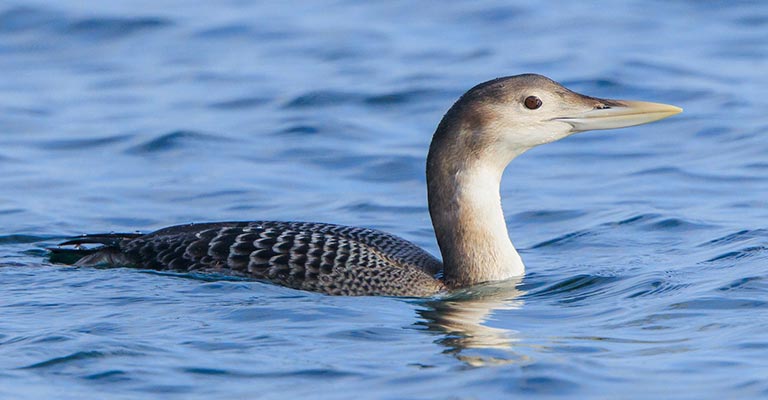
Check out the table below detailing the taxonomy details of the Yellow-billed Loon:
| Taxonomic Rank | Classification |
| Domain | Eukaryota |
| Kingdom | Animalia |
| Phylum | Chordata |
| Class | Aves |
| Order | Gaviiformes |
| Family | Gaviidae |
| Genus | Gavia |
| Species | G. adamsii |
The Yellow-billed Loon (Gavia adamsii) belongs to the family Gaviidae within the order Gaviiformes.
Classified under the genus Gavia, it shares taxonomic similarities with other loon species, such as the Common Loon (Gavia immer) and the Pacific Loon (Gavia pacifica).
Within its genus, the Yellow-billed Loon is distinguished by its larger size, distinctive yellow bill, and unique breeding and migration behaviors.
As a member of the Gaviidae family, it is adapted for an aquatic lifestyle, with specialized features for diving and swimming in the cold waters of its Arctic habitat.
Hunting Habit of Yellow-billed Loon
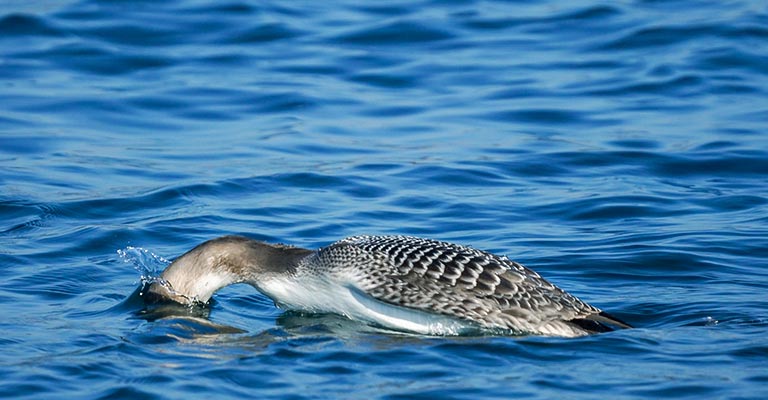
The Yellow-billed Loon is a skilled hunter, primarily preying on fish as its primary food source. Utilizing its streamlined body and powerful webbed feet, it dives beneath the water’s surface in pursuit of its prey.
With its sharp, yellow bill, it grasps and precisely captures fish. This species is known for its ability to dive to impressive depths, reaching up to 60 meters (200 feet) underwater in search of food.
Yellow-billed Loons often hunt alone rather than cooperatively, unlike other loon species. They are opportunistic feeders, consuming crustaceans, insects, and occasionally small mammals or birds when available.
Their hunting habits are finely tuned to the rhythms of Arctic lakes and coastal waters, where they exhibit remarkable agility and efficiency in capturing their aquatic prey.
Yellow-billed Loon Life History
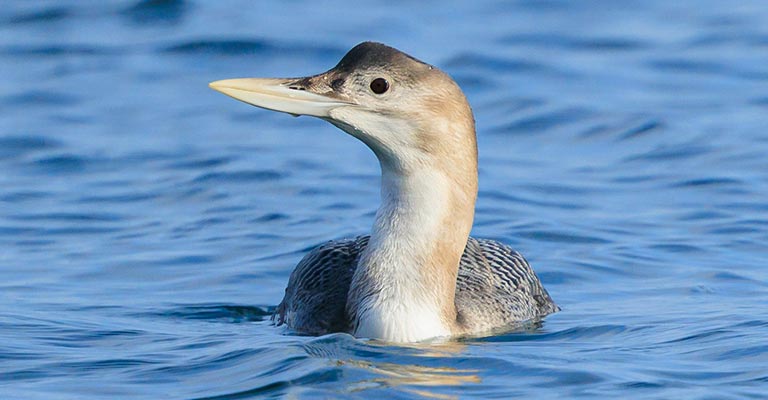
The Yellow-billed Loon (Gavia adamsii) is a fascinating Arctic bird species renowned for its striking appearance and remarkable adaptability to harsh northern environments.
From its feeding habits to its nesting behavior, this bird’s life history is characterized by unique adaptations that enable its survival in challenging ecosystems.
Food
Yellow-billed Loons are primarily piscivorous, meaning they predominantly feed on fish. Their diet consists mainly of small to medium-sized fish species found in the cold waters of Arctic lakes and coastal regions.
Additionally, they may consume crustaceans, insects, and occasionally small mammals or birds when fish are scarce.
With their streamlined bodies and powerful diving abilities, Yellow-billed Loons are adept at catching prey underwater, diving to considerable depths to pursue their quarry.
Habitat
Yellow-billed Loons inhabit remote and pristine Arctic lakes, ponds, and coastal waters during the breeding season. These birds prefer large, deep bodies of water with abundant fish populations for feeding.
They are particularly associated with regions with a mix of open water and aquatic vegetation, providing suitable nesting sites and ample food resources.
Range Map
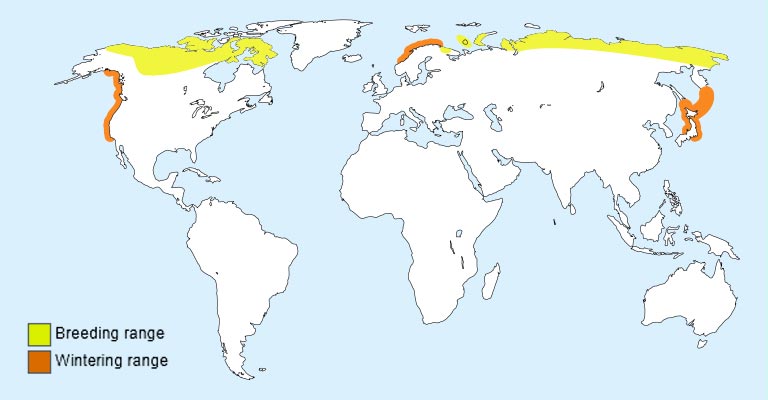
The Yellow-billed Loon’s range spans the high Arctic regions of North America and Eurasia. They are found in northern Canada, Alaska, Greenland, and parts of Russia during the breeding season.
In winter, they migrate southward to more temperate coastal waters, including the northern Pacific and Atlantic coastlines.
Nesting
Yellow-billed Loons typically build their nests near the water’s edge, often on small islands or peninsulas within their breeding territories.
The nests are constructed from vegetation, grasses, and feathers, providing a secure environment for incubating eggs and raising chicks.
Both male and female loons participate in nest-building and incubation duties, taking turns to protect and warm the eggs.
Go through the table below detailing the nesting details of the Yellow-billed Loon:
| Nesting Details | Facts |
| Clutch Size | 1-3 eggs |
| Number of Broods | Usually 1 per breeding season |
| Egg Length | Approximately 9-10 centimeters (3.5-4 inches) |
| Egg Width | Approximately 5-6 centimeters (2-2.5 inches) |
| Incubation Period | Around 26-29 days |
| Nestling Period | Approximately 8-9 weeks |
| Egg Description | Pale green to olive-brown with dark spots and blotches |
| Nest Description | Constructed from vegetation, grasses, and feathers, typically near the water’s edge on islands or peninsulas within the breeding territory |
| Parental Care | Both male and female participate in nest building and incubation, taking turns to ensure eggs are protected and warmed |
| Nest Predation | Vulnerable to predation by mammals, birds, and occasionally other loons |
| Nesting Habitat | Remote and pristine Arctic lakes, ponds, and coastal waters with a mix of open water and aquatic vegetation |
This table provides a concise overview of the nesting habits and characteristics of the Yellow-billed Loon, including clutch size, egg dimensions, incubation and nestling periods, egg description, nesting habitat, and parental care behavior.
Breeding
Breeding in the Arctic occurs during the short summer months when the ice retreats from the lakes. Yellow-billed Loons are monogamous and form pair bonds lasting for multiple breeding seasons.
Mating displays involve elaborate courtship rituals, including synchronized swimming and vocalizations. After mating, the female lays one to three eggs, which both parents incubate for approximately four weeks until hatching.
Diseases and Treatment
Like many bird species, Yellow-billed Loons may be susceptible to various diseases, including avian botulism, avian influenza, and parasites.
Monitoring and research efforts are crucial for understanding and mitigating disease outbreaks in wild populations.
Treatment for sick or injured birds may involve rehabilitation in specialized facilities, followed by release back into the wild if deemed healthy.
Conservation
Yellow-billed Loons face numerous threats to survival, including habitat degradation, pollution, climate change, and disturbance from human activities such as oil and gas development.
Conservation efforts aimed at protecting their breeding and wintering habitats, minimizing disturbances, and reducing pollution are essential for ensuring the long-term viability of this iconic Arctic species.
Collaborative research and conservation initiatives involving governments, researchers, conservation organizations, and local communities are critical for safeguarding the Yellow-billed Loon and its fragile Arctic ecosystem.
10 Behavioral Habits of Yellow-billed Loon
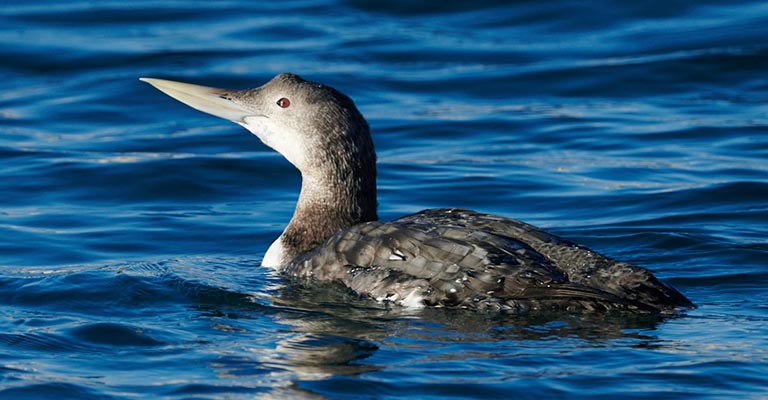
The Yellow-billed Loon (Gavia adamsii) exhibits a fascinating array of behavioral habits finely tuned to its Arctic habitat and lifestyle.
From its hunting techniques to its social interactions, these behaviors are integral to its survival and reproductive success in the challenging environments it inhabits.
- Diving Expertise: Yellow-billed Loons are skilled divers, capable of plunging to impressive depths in pursuit of fish and other aquatic prey. Their streamlined bodies and powerful webbed feet enable them to navigate underwater swiftly and precisely.
- Territorial Defense: During the breeding season, Yellow-billed Loons fiercely defend their nesting territories against intruders, engaging in aggressive displays and vocalizations to ward off potential threats.
- Courtship Rituals: Mating pairs engage in elaborate courtship displays, including synchronized swimming, head shaking, and vocal duets, to strengthen their pair bonds and prepare for breeding.
- Parental Care: Both male and female Yellow-billed Loons participate in incubating the eggs and caring for the young chicks after hatching, demonstrating a high level of parental investment in offspring survival.
- Vocalizations: Yellow-billed Loons are known for their haunting and mournful calls, which serve various purposes, including territory defense, mate attraction, and communication between mating pairs and family members.
- Migration Patterns: These birds undertake long-distance migrations between their breeding and wintering grounds, following established routes to reach their destination.
- Feeding Behavior: Yellow-billed Loons primarily hunt for fish underwater, utilizing their sharp bills and agile swimming skills to capture prey. They are opportunistic feeders, consuming crustaceans, insects, and occasionally small mammals or birds.
- Social Interactions: While typically solitary during the breeding season, Yellow-billed Loons may congregate in loose groups on wintering grounds, engaging in social interactions such as foraging and vocalizing.
- Nest Building: Mating pairs construct nests from vegetation, grasses, and feathers, typically located near the water’s edge on islands or peninsulas within their breeding territory.
- Adaptations to Climate: Yellow-billed Loons have evolved physiological and behavioral adaptations to cope with the extreme cold and seasonal fluctuations in food availability in their Arctic habitat, ensuring their survival in this harsh environment.
These behavioral habits collectively contribute to the Yellow-billed Loon’s success as a species, allowing it to thrive in one of Earth’s most challenging and dynamic ecosystems.
Wrapping Up
The Yellow-billed Loon is a remarkable testament to the adaptability and resilience of avian life in the Arctic.
Its distinctive characteristics, from its striking appearance to its intricate behavioral patterns, underscore its importance in the fragile ecosystems of the far north.
As a sentinel species for environmental health, the conservation of the Yellow-billed Loon and its habitat is vital for the species itself and indicative of the overall health of Arctic ecosystems.
Through continued research, conservation efforts, and public awareness, we can work together to ensure the preservation of this iconic bird and the ecosystems it inhabits for generations to come.